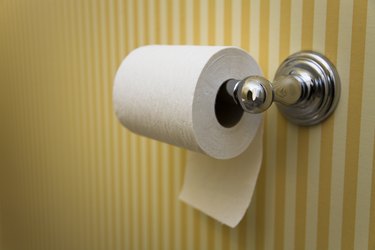
Excuse our potty language, but we really need to talk about your stool. Even though it isn't the subject of polite conversation, many people pay attention to what's lurking in the toilet bowl — and floating poop just might raise a red flag.
Especially when you're trying to lead a healthy lifestyle, you might be studying every meal, workout and bodily function. So when your number two is bobbing at the water's surface, it's reason to think about what's happening internally.
Video of the Day
Video of the Day
Here, doctors and registered dietitians share what buoyant bowel movements could say about your health.
What Does Floating Poop Mean?
After a visit to the bathroom, you give a quick glance before you flush. While it normally sinks to the bottom, your stool is floating. When this happens, it could mean one of a few things.
1. Excess Gas
One culprit is excess air from intestinal gas, says Moe Schlachter, RD, LD, dietitian and certified diabetes educator. "Transient increases in gas are a normal occurrence and a common cause of floating stools," he says.
In other words, if it happens once or occasionally, it's probably nothing to worry about. Keep in mind that foods high in fiber — including beans and many fruits and veggies — can cause gas, especially when you eat more than you normally do.
2. Gastrointestinal Disorder
Some GI disorders can cause poop to float. In fact, an August 2015 study in the European Journal of Gastroenterology & Hepatology found that more than a quarter of people with functional bowel disorders (think: IBS) had floating stools.
If floating poop occurs with other GI symptoms like pain, bloating, diarrhea or constipation, it could be a warning sign of a bowel disorder.
3. Too Much Fat
If you're noticing floaters in the bowl more often than not, it might mean there's too much fat in your stool, which can signal a larger problem. "Fat in the stool indicates a malfunction of digestion or absorption of nutrients and can be a symptom of a more serious health issue," Schlacter says.
Think about it: When you mix oil (fat) and water together, what happens? Oil will rise and sit above the water. This is basically what's happening when poop floats.
According to licensed dietitian and certified nutrition specialist Anthony Crifase, LDN, CNS, this may mean that your body isn't properly breaking down the fat in your diet. The culprit could be a food intolerance, a problem with the small intestine or an issue with one of the organs involved with digestion, including the liver, gallbladder or pancreas.
Warning
If you notice your poop floating more often than not, and especially if you have other digestive symptoms, make an appointment with your doctor as soon as possible.
So, What Does Healthy Poop Look Like?
Part of understanding our bodies is paying attention to what we eat — and what we release. To track what's good news and what's potentially bad, Schlachter recommends consulting the Bristol Stool Chart, which breaks down the seven most common poop textures and what they mean. Normal stool is sausage-shaped, either smooth or with cracks.
When it comes to color, Schlachter says varying shades of brown to green are healthy and affected by the content of our diet.
Another part of a healthy number two is frequency. Crifase says regularity is very important to keeping our bodies running efficiently. "Making sure that you are having daily bowel movements ensures that the gastrointestinal system is working smoothly and functioning properly. The more spaced out your bowel movements, the longer food sits in the gut and can ferment and putrefy, which creates problems," he says.
For most people, this means a trip to the throne once a day.
What Does Unhealthy Poop Look Like?
In addition to floating, stool can be deemed unhealthy if it has other characteristics. The most vital aspects to look out for include color and texture.
Crisfaste says if it's hard to pass or is incredibly liquid, it's unhealthy.
The shade of our poop is also a biggie, according to Schlachter. "Yellow stool can indicate the presence of undigested fat. Pale stool can be caused by a shortage of available bile, a biochemical necessary for healthy digestion. Bright red or jet black stool can mean intestinal bleeding," he explains.

Tips for Healthier Poop
Lauren Slayton, RD, registered dietitian and founder of FoodTrainers, says healthy poop is 'S' shaped and brown. That's a good sign that your digestion is humming along.
If you aren't quite there yet, it's probably OK, but you might want to try these tips to improve quality. And if you're concerned, never be afraid to raise these uncomfortable questions with your doctor. (Trust us, they've seen worse!)
1. Get Enough Fiber
Dietitian Bonnie Taub-Dix, RDN, says the majority of people don't get enough fiber. Fiber offers a bevy of health benefits and can be found in most fruits and vegetables along with whole-wheat grains, legumes, nuts and seeds, per the Mayo Clinic.
Women should try to eat between 21 and 25 grams of fiber each day, while men should aim for 30 to 38 grams. To put that into perspective, a cup of raspberries contains about 8 grams of fiber, while a cup of lentils has more than 20.
2. Drink More Water
Water not only keeps us hydrated but is also a big help to our digestive tract. "Fluid gives stool its agility, allowing it to move easily through your system and reach its destination on time," Schlachter says.
Read more: How Much Water Should I Drink Every Day?
3. Get Regular Exercise
In addition to helping us maintain our weight, exercise keeps things, well, moving.
"Fitness activities like walking or running help stimulate the muscle movements that are needed for your stool to pass," Schlachter says. "The jostling of impact exercise can free the matter that clings to the intestinal wall so it can leave the body."
The Physical Activity Guidelines for Americans recommend getting at least 150 minutes of moderate-intensity aerobic exercise and 75 minutes of vigorous-intensity exercise each week.
- European Journal of Gastroenterology & Hepatology: "Are floating stools associated with specific functional bowel disorders?"
- Continence Foundation of Australia: "Bristol Stool Chart"
- Mayo Clinic: "High-Fiber Foods"
- USDA FoodData Central: "Raspberries, Raw"
- USDA FoodData Central: "Lentils, Raw"
- Office of Disease Prevention and Health Promotion: "Physical Activity Guidelines for Americans, 2nd Edition"
Is this an emergency? If you are experiencing serious medical symptoms, please see the National Library of Medicine’s list of signs you need emergency medical attention or call 911.